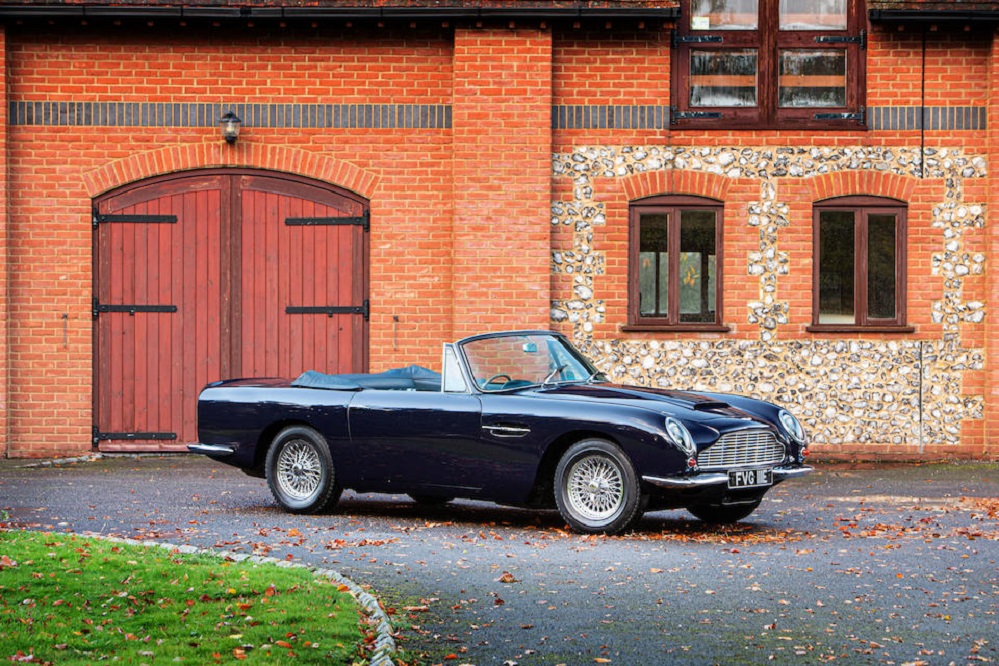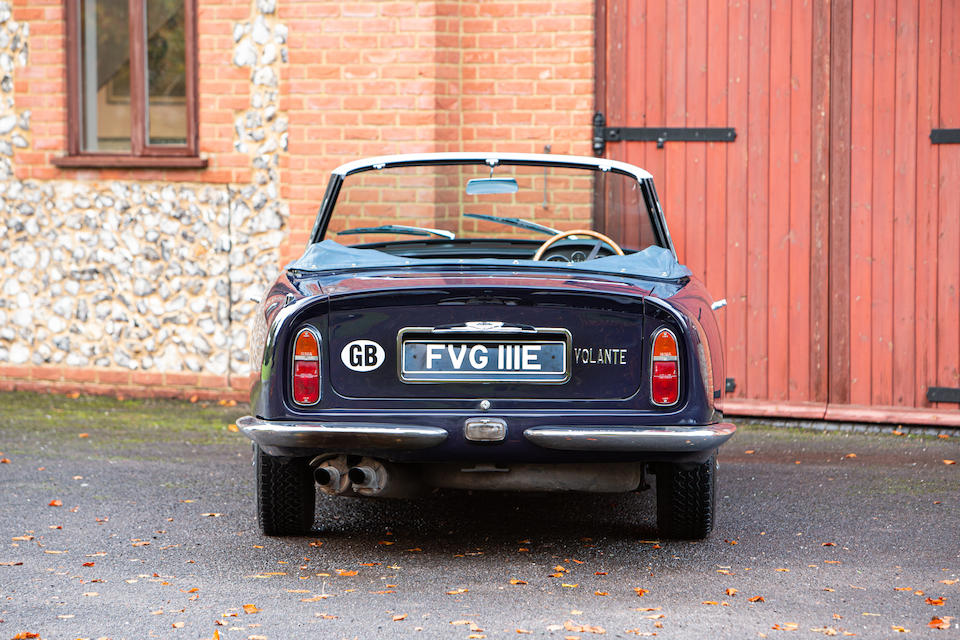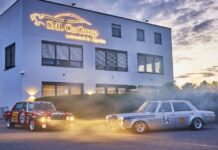“I have driven most of the Aston Martin models that have been produced, from the racing twin-cam 1½-litre of the 1920s onwards. For years my favourite has been the DB3S sports-racer, but now my allegiance is wavering. There can be little doubt that the DB6 is the best Aston yet and it is a credit to British engineering.” – John Bolster, Autosport, 21st October 1966.

Registration No. FVG 111E
Chassis No. DBVC/3650/R
*One of only 29 DB6 Mk1 Vantage Volantes made
*Single family ownership for the last 44 years
*Extensively restored by DK Engineering in the 1980s
*Used for summertime touring and always maintained to the highest standard
The culmination of Aston Martin’s long-running line of ‘DB’ six-cylinder sports saloons, and thus considered by many to be the last ‘real’ Aston, the DB6 was introduced in 1965, updating the DB5. Although Royal patronage of the marque undoubtedly helped DB6 sales, as did its DB5 predecessor’s appearance in the James Bond movies ‘Goldfinger’ and ‘Thunderball’, the car arrived at a difficult time for Aston Martin, with the home economy in a parlous state and the US market subject to ever-more restrictive legislation.
Although recognisably related to its Touring-styled DB4 ancestor, the DB6 abandoned the underlying Superleggera body structure of its predecessors in favour of a conventional steel fabrication while retaining the aluminium outer panels. Somewhat confusingly, ‘Superleggera‘ badges continued to be applied for a time, presumably until stocks ran out. Increased rear-seat space was the prime DB6 objective so the wheelbase was now 4″ longer than before, resulting in an extensive restyle with more-raked windscreen, raised roofline, and reshaped rear quarter windows. Opening front quarter-lights made a reappearance but the major change was at the rear where a Kamm-style tail with spoiler improved the aerodynamics, greatly enhancing stability at high speeds. This aerodynamic device had first been tried on the DP214 and DP215 DB4GT-based Le Mans prototypes – yet another example of racing improving the breed. These many dimensional changes were integrated most successfully, the DB6’s overall length increasing by only 2″. Indeed, but for the distinctive Kamm tail one might easily mistake it for a DB5.
“The tail lip halves the aerodynamic lift around maximum speed and brings in its train greater headroom and more luggage space,” revealed Motor magazine, concluding that the DB6 was one of the finest sports cars it had tested. “The DB6 with its longer wheelbase and better headroom makes an Aston Martin available to the far wider four-seater market, and the design is in every way superior to the previous model. A purist might have though that the longer wheelbase would affect the near-perfect balance of the DB5, but if anything the DB6 is better.”

The Tadek Marek-designed six-cylinder engine had been enlarged to 3,995cc for the preceding DB5 and remained unchanged. Power output on triple SU carburettors was 282bhp, rising to 325bhp in Vantage specification. Borg-Warner automatic transmission was offered alongside the standard ZF five-speed gearbox, and for the first time air conditioning and power-assisted steering were available as options.
Motor clearly appreciated the power and poise of their test Vantage: “In an effortless way that few other cars can match, the DB6 makes an overall speed limit of 70mph look quite ridiculous. At its maximum speed of more than twice this, it is reassuringly stable, probably more so than many cars struggling to maintain their 70mph convoy speed. If you need to stop from high speed the brakes are outstandingly powerful, a point which really needs remembering if there is a less well endowed vehicle behind; and the handling in both wet and dry conditions is superior to all but a couple of the production two-seater sportscars we have tested.”
Premiered at the 1965 London Motor Show, the convertible version of the DB6 marked the first occasion the evocative ‘Volante’ name had been applied to a soft-top Aston Martin. After 37 Volante convertibles had been completed on the DB5 short-wheelbase chassis, the model adopted the longer DB6 chassis in October 1966, first appearing in its definitive form at that year’s London Motor Show. The stylish Volante offered four-seat accommodation and was generously appointed with leather upholstery, deep-pile carpets, an aircraft-style instrument cluster, and an electrically operated hood.
In the summer of 1969 the Mark 2 DB6 was announced in saloon and convertible versions. Distinguishable by its flared wheelarches and DBS wheels, the DB6 Mark 2 came with power-assisted steering as standard and could be ordered with AE Brico electronic fuel injection. Between 1965 and 1970 when production ceased, a total of 1,575 DB6 saloons was completed. During this time the factory made only 178 of the long-wheelbase Volantes and today these rare cars are among the most sought after of David Brown-era Aston Martins.
It is an irony that, having brought the original DB4 concept to perfection in the form of the DB6, Aston Martin chose to change direction with the larger DBS and successor V8-engined models. Today the accomplished DB6, despite being the most evolved and practical of the original DB family, is also – somewhat paradoxically – the most affordable.

One of 140 ‘Mark 1’ DB6 Volantes made, only 29 of which were fitted with the Vantage engine, ‘DBVC/3650/R’ was supplied new in May 1967 via Botwoods to Mecca Ltd, the London-based leisure business that ran nightclubs, hotels, theme parks, bingo parlours, and Hard Rock Cafés. The accompanying copy guarantee form records the original registration as ‘FVG 111E’ (the same as it is today) and lists the following items of non-standard equipment: Vantage engine; power steering; chrome road wheels; 3-ear hubcaps; power aerial; Motorola radio; lap and diagonal safety belts; and a detachable headrest. The original colour scheme was Mink with dark blue Connolly leather interior and matching Everflex hood. The only service work recorded is the fitting of five new road wheels in February 1971 at 28,022 miles (the current odometer reading is 98,705 miles).
For the last 44 years ‘FVG 111E’ has belonged to the vendor’s family – owners of the world-famous Ecurie Ecosse Collection – and in the mid/late 1980s was extensively restored by DK Engineering (see correspondence and detailed bills on file). The car was originally serviced by Alexander Hillyer Engineering based near Thame, Oxfordshire: a well-respected Aston Martin and classic car service garage. Unfortunately, when the proprietor passed away in the late 1990s the business was discontinued. From the late 1990s the vendor’s family has employed Alexander Engineering’s former head mechanic directly. The maintenance and servicing for the DB6, the Ecurie Ecosse Collection, and a number of other valuable cars has been done in house utilising the vendor’s own workshop and facilities.
Boasting extended-range fuel tanks, the Aston has been used for summertime touring and always maintained to the highest standards. The very pinnacle of British open-top motoring in the 1960s, this beautiful DB6 Vantage Volante benefits from long-term enthusiast ownership and is worthy of the closest inspection.
Report by bonhams.com










